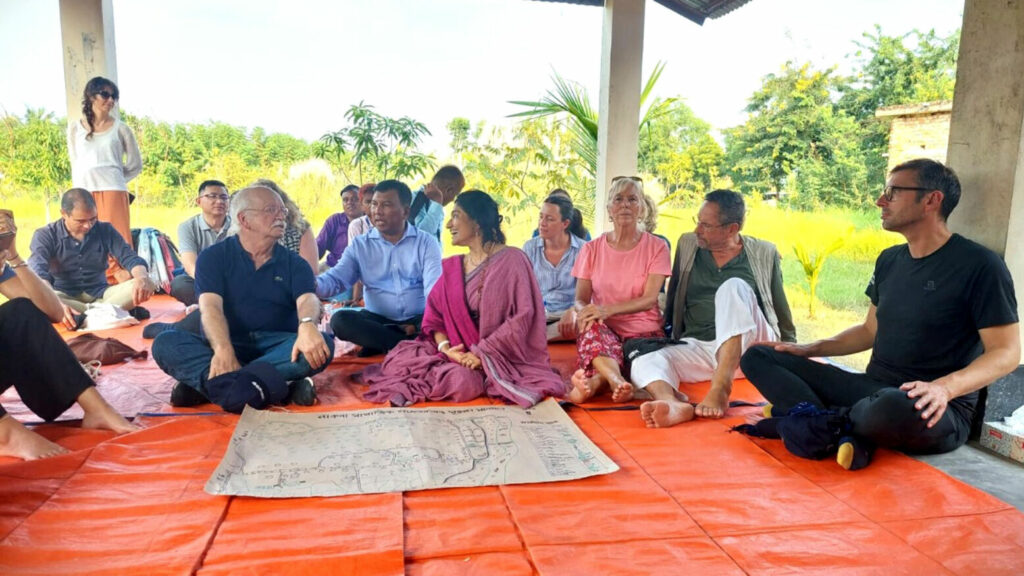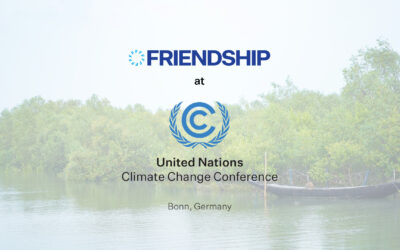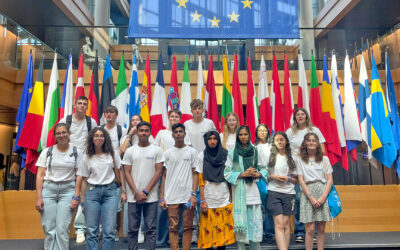In this South Asian state, characterised by extreme poverty and the highest population density, the monsoon and river flooding, which is becoming ever more violent with climate change, floods a third of the country every year. The inhabitants are struggling to cope with the inexorable rise in water levels, fleeing the countryside to take refuge in already overcrowded towns.

by Erik Orsenna,
(Translation by Clémentine Charron)
May 2, 2024
“Chars”, are nomadic islands that appear and disappear at the river’s whim, and where families come to find refuge.
It was once a region of the world blessed by the gods. The daughter of two great rivers from Tibet. Infinitely fertile with all the sediments carried by their waters. And bordered by the most tranquil of ocean gulfs.
Admittedly, the seasonal rains known as the monsoon flooded the soil from time to time. But how could we not see this as another gift from heaven? Additional sources of life to multiply harvests.
For a long time, this region was called Bengale. It was first a Buddhist kingdom, then a Muslim one, before becoming part of India, the jewel in the crown of the British colonial empire. Suddenly, in the middle of the summer of 1947, the long-awaited moment of independence arrived. A celebration marred by the horrors of partition and the millions displaced. Everyone knows that births, for those who give birth, are no picnic.
Thus, a new country called Pakistan, was divided into two pieces. Yes, two pieces, the invention of diplomats, two pieces separated… by 1,600 kilometres, four provinces to the west and one to the east. The latter, of course, eventually demanded its freedom, which it won after hard fighting in 1971. The western part kept its name of Pakistan. The eastern part chose Bangladesh, “the homeland of the Bengalis”, or rather, the homeland of those who speak Bengali. Today, every 21 February, in memory of this history, we celebrate International Mother Language Day, recognised as a world heritage site by UNESCO. No other person has won its independence based on a language.*
Friendship’s Mad Gamble
My love for the region began fifteen years ago when I came here to carry out my research into the “future of water”. Where better to find my character than in this “land of 300 rivers”? A magnificent being had guest, Yves Marre, an Air France steward. To bring relief to villages deprived of any medical support, he had the crazy idea of buying a barge in Saint-Quentin, yes, a good old Freycinet, taking it through the canals to Fos-sur-Mer, fitting it out as best he could, and taking it to Bengal, via the Mediterranean, the Suez Canal and the Red and Oman Seas.
It was on the banks of the Brahmaputra that I found him, upstream from the capital Dhaka. His long-haul barge had been transformed into a… river hospital thanks to the intervention of a fairy who had convinced Unilever Asia to finance the transformation! Every day, dozens of villagers who had come on foot to recover their sight underwent cataract surgery. Thus began Friendship, the best-named and most active of the non-governmental organisations.
Is their only music that of the passing river? Like life itself.
Like a time that doesn’t say its name
As you can imagine, Yves fell madly in love with the fairy, who must have known the name: Runa Khan. On his boat, a giant junk named B613 to salute a star, we had a magical memory of visiting the “chars”, nomadic islands that appear and disappear at the river’s whim. If they don’t want to drown, the families have no choice but to find refuge elsewhere, until the next flood.
You can see why this country has entered my heart and will never leave it again. Not many of us have ever sailed the confluence of the Ganges and Brahmaputra rivers! Today, Friendship brings together more than 6,000 people of all statuses and skills, working in full collaboration with the State in all the crucial sectors (health, education, social assistance). All these activists share the same conviction that a better future is possible, despite the countless obstacles placed in the path of Bangladesh by the gods.
The valour of an entire people
Bangladesh, with 170 million inhabitants, is concentrated on a third of the surface area of France.
Bangladesh is a national territory that is already halved every two years.
Bangladesh, undoubtedly the world’s victim least responsible for climate change (0.7 tonnes of CO2 consumed per Bangladeshi, compared with 5 in Europe, 15 in the United States and 35 in Qatar), is at the same time the most severely affected, with a succession of droughts and floods, an increase in extreme climatic phenomena, and rising seas caused by ever-increasing heat.
But Bangladesh is not only suffering from this degraded atmosphere. Geography has played a very nasty trick on it. True, it has given it these two immense rivers, the engines of its incomparable fertility, but it has been quick to compensate for its generosity with a trap: these two giants were born elsewhere, in India and China, two giants that, who have not been accustomed to sharing, consider them to be their personal property.
How can you manage the flow of water and sediment on which your existence depends if the giants are happy to build all the dams they want upstream?
At the start of 2024, here I am again on the banks of the Brahmapootra. Friendship has invited our association, Initiatives pour l’avenir des grands fleuves, to discuss the practical possibilities of working together. It was a thrill to meet up again with these people of “chars”. Forced to abandon their homes as soon as the water rises, to recreate a new town further on, on land that’s barely emerged. Valiant, valiant people of the ‘chars’, perhaps the last nomads on our planet, now that the slow meharées have become motorised journeys. But let’s make no mistake. Other vast population movements are in the offing, generated by the follies of time. In the “chars” are those we call climate refugees, threatened with losing everything at any moment. And yet… When you share the lives of these people for a few days, you sense a very strange and admirable sovereignty, the kind that comes from (forced) freedom and (forced) intimacy with what is essential.
Do they have their own song? Or is their only music that of the passing river? Like life. Like a time that does not say its name.
On the Road again. On the River again. Once again, the valour of the Bangladeshi people overwhelmed me, their smiles in all circumstances, their open arms, and their welcome from all generations.
Do you want to understand the instability of these places? Listen to Laurent’s story. One day, he launches a drone, to show just how wide the river is, those 20 kilometres from one bank to the other. And he watches. One eye on the sky, the other on Google Maps, the fairy godmother of modern travellers. Poor photographer! No coordinates matched, yet everyone knew how the drone’s data was “fresh”, constantly updated with the help of satellites. Poor drone, it was losing its head: where Google told it there was an island, there was only water. And where there was supposed to be only current, there was a long stretch of sand. Digital technology is said to be drunk with speed. It is still very slow when faced with the whims of the Brahmaputra.
The city is our only refuge
Why settle there, you may ask, why in such an uncertain land? The answer is simple: these people had to flee, flee the southeast of the country where the sea was rising. And where to go? The cities are already overcrowded: Dhaka, the capital, already has 23 million inhabitants; all the spaces are full, including the stations, with families camping out on the tracks and moving aside when a train leaves or arrives. So you continue on your way and end up stranded on these crumbly earthen boats, one of those islands that could sink at any moment. Immigrants, of course, but immigrants within their own country. The first waves of climate refugees, the harbingers of many more to come.
Where to go? The cities are already overcrowded. Dhaka already has 23 million inhabitants.
Just long enough to salute the work of Friendship, its tireless support for these communities deprived of everything, and first and foremost of the slightest certainty of the future, we set off towards the source of this exodus.
The road is not long in terms of kilometres, but it is interminable because of the incredible crowds that criss-cross it day and night: passers-by of all ages, bicycles, overloaded rickshaws, motorbikes in too much of a hurry, lorries that are too wide and animals that are much more disciplined than their invisible masters, families of goats, herds of sheep sauntering along the roadside. As the road also acts as a dyke, the landscapes and colours clash. On the left, as far as the eye can see, is green rice. On the right, as far as the horizon, flat grey water. I’m told they raise prawns here.
Why this influx of shellfish? The culprit is salt from the nearby sea. As soon as a certain level of salinity is exceeded, the rice refuses to grow, even though a number of research projects aim to increase its tolerance. Fortunately for the local economy, prawns and their little cousin, the crab, have taken over. This change is not without social consequences. Shrimps are more profitable but require more capital. Urban entrepreneurs are gradually replacing the farmers and, as they make more profit from exports, the region’s food self-sufficiency is diminishing, and with it that of the country.
In the maze of the Sundarbans
Water was already everywhere. Now it occupies almost all the space. The end of this delta country is not far away, the sea is getting closer, just 30 or 40 kilometres. We are entering the mythical region of the Sundarbans, sundri being the name of the dominant plant, and ban meaning country. This gigantic mangrove, the largest in the world at 140,000 hectares, is shared by India and Bangladesh.
Mangrove: “brackish water ecosystem, developed along tropical and subtropical coasts; not very diverse flora, mainly mangroves, but very rich fauna”. In other words, a forest with its feet in the water. In 1997, the Sundarbans became a UNESCO World Heritage Site. Part of it has become a nature park, in the hope of safeguarding a few wild animals. But other parts remain authorised. Our little boat spent a long time wandering through this maze. For hours, we waited for THE tiger, but it never came. The likelihood of seeing Shere Khan, or for want of a better word, one of his family, was slim. According to the latest statistics, which are difficult to verify, except at the risk of one’s life, there are only 114 striped felines left in these parts. Once we had got over our disappointment and closed our Jungle Book, we had to return to harsh realities.
The first stop is a mangrove replantation or rather a nursery. This is one of the tasks Friendship has set itself. Of course, it’s impossible for her to replant all the banks and walls of this “head of water” with vegetation, of this giant vascular plant. All we have to do – and this is a major challenge – is develop a method and choose the most resistant species and the fastest to grow. And then proving, over many kilometres, that it can be done! Yes, mangroves can be reborn! For the greater benefit, and first and foremost the protection, of all the communities that did not want to flee and are determined to remain in the delta where they were born.
The Ocean is an ogre. After creating life, he wants to destroy it.
It’s important to understand that a mangrove is not a hedge or a plant barrier. You who have never sailed have no idea of the violence of which the wind is capable. A curtain of trees will be blown over in a second, at the first gust. To have any chance of resisting the fury of the sea stirred up by cyclones, the mangrove has to stand up to it with the presence, the consistency and the strength of its vegetation.
It’s the depth of another element, its roots deep in the mud, its animals of all sizes and survival strategies. Universe against universe, forest against ocean.
A dam against the ocean.
The Ocean is an ogre, from the very first mythology. After creating life, he wants to destroy it. A well-known behaviour of monarchs! He is happy to accept a successor. Against this infantile rage, we have destroyed one of our most faithful allies.
Mangroves, O subtle fighters, why are we deprived of your help? Compa- rated to your tricks, how stupid concrete is, how quickly any dyke is bypassed, ruined barely in time to have raised its financing! In any case, the most effective barrier against the onslaught of the sea. Today, the door is open to the rising seas and the fury of cyclones. Second stopover. A long walk on a dike of dried mud. From a grove of palm trees, in the distance, beyond the pools shrimps, and the music plays at the top of its lungs. Buddhist festival or wedding? My guides can’t decide. We pass through a miniature village, more of a motley collection of wooden and tin huts huddled around a mosque that looks more like a shed. The very embodiment of fragility, on the front line of the battle being waged ever more fiercely against the steady advance of the ocean and the multiplication of cyclones. A simple breeze could sweep them away.
How exotic is Bangladesh? What if this country were much closer to us in time than it is in space?
Friendship understands the fear in our eyes. So here we have a refuge, one of more than a thousand built on this coast to provide shelter in the event of a hurricane. It’s two storeys high and made of solid concrete, but I’m told it’s very solid and ecological quality, as it contains only a third of the sand taken from the river. During the critical forty-eight hours, families will have access to drinking water, toilets and a surface area of one square metre per person. Thanks to these shelters, cyclones are on the increase – up to three a year – but the death toll is falling. That’s nothing like the 500,000 people who died when Bhola hit on 12 November 1970. Good news, isn’t it?
Where are the husbands?
Two questions come to mind. I’ll keep the first one to myself. No doubt 30 million people continue to live in these very lowlands.
“Have you, will you have enough refuges to house them all?” The other question comes out of nowhere: “Where are the husbands? All I’ve seen since this morning are wives and children! Answer: “As the sea rises and with it the salt, it’s no longer possible to farm. The men have gone off to try and earn a bit of money elsewhere. In Dhaka, for example, there are more than 500,000 rickshaws. All driven by refugees from the Sundarbans”.
Bangladesh, three syllables synonymous with human poverty and the almost daily aggression of the natural elements. And yet I don’t think I’ve ever seen, anywhere, a people so valiant in the face of adversity, so tolerant in the face of diversity, so respectful of others in the face of demographic pressure, so cheerful in the face of the constant aggressions of life. Exotic, Bangladesh? I’m familiar with the word, often used as an insult. Exotic, my long report on water? How do you expect France, a temperate country, to suffer one day from drought? How exotic was my mosquito alert? Today, every French department is home to Anopheles mosquitoes that can carry dengue fever. So is Bangladesh exotic? What if this country were much closer to us in time than in space? And what if, in the strategies being developed there to combat all kinds of disruption, we could soon find some very useful answers here at home?
Note: This article was originally published in French on LeFigaro on April 28, 2024. Further reading about Erik Orsenna’s involvement with Friendship can be found here and here. Opinions and information expressed in this article are those of the author and do not necessarily reflect those of Friendship.
* Editor’s note: In the interest of historical accuracy, a number of interrelated socioeconomic and political factors and events led to Bangladesh’s struggle for independence, culminating in a nine-month war from March – December 1971. It may also be mentioned that International Mother Language Day commemorates the martyrdom of a number of students and civilians from the University of Dhaka during the Language Movement and not the start of the movement itself.



